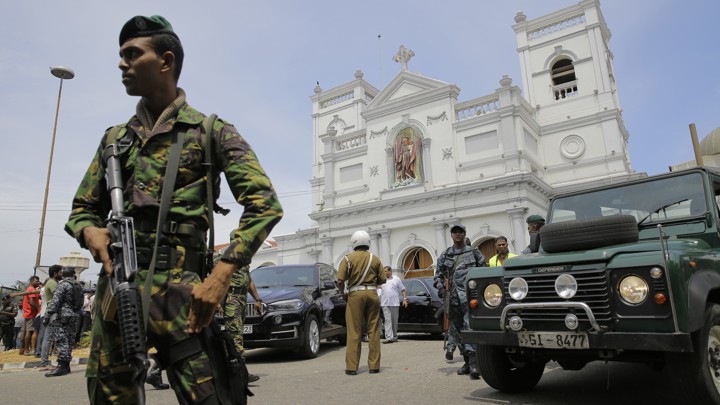KRISHNADEV CALAMUR
 When ISIS claimed responsibility for the coordinated bombings in Sri Lanka that killed more than 350 people, it did so, as one would expect, in Arabic and English. But it also issued statements in other languages—including Tamil.
When ISIS claimed responsibility for the coordinated bombings in Sri Lanka that killed more than 350 people, it did so, as one would expect, in Arabic and English. But it also issued statements in other languages—including Tamil.
There is yet no independent verification of the terrorist group’s claim, but the pronouncement in a language spoken by about 70 million people, overwhelmingly in the southern Indian state of Tamil Nadu and in northern and eastern Sri Lanka, as well as in Malayalam, spoken by about 35 million people mostly in the southern Indian state of Kerala, suggests the organization has recruits fluent in what are essentially regional languages with relatively few speakers.
It is this sort of targeted outreach at which ISIS is particularly good: Like other militant groups, ISIS exploits weak governments, but it also capitalizes on disenfranchisement among Muslim minorities, speaks to their particular grievances, and looks to recruit educated professionals for its sophisticated propaganda efforts.
On the face of it, ISIS’s influence in South Asia is limited. About 180 Indians are said to have joined the group out of a population of 170 million Indian Muslims, according to the Observer Research Foundation (ORF), a think tank in New Delhi. (Muslims are the largest religious minority in the nation of 1.2 billion.) But the majority of those who did are from the south. Sri Lanka’s case is similar: About 32 Sri Lankan Muslims have fought with ISIS in Syria, ORF says. (Muslims make up about 10 percent of Sri Lanka’s population of 21 million.)
“Overall, they haven’t been successful,” Kabir Taneja, who studies terrorism in South Asia at ORF, told me. “The number of cases compared to the population, especially compared to the Muslim population, is really, really low.”
ISIS’s real success in recruitment has come in the places one would expect: the Arab world, Central Asia, and western Europe. But while it struggled to attract recruits in places such as India, it has drawn fighters from as far afield as Trinidad and Tobago (which Simon Cottee wrote about for The Atlantic), Cambodia, Australia, parts of Southeast Asia, and even Chile. It has been able to do this mainly through its tremendous success on the battlefield in Iraq and Syria, as well as its declaration of a caliphate, which it trumpeted aggressively in its propaganda and media operations.
“There’s a lot of hyperbole that surrounds the Islamic State, but two areas in particular that weren’t hyperbole: how much money the group made, and the sophisticated nature of its media apparatus,” Colin Clarke, an expert on ISIS who is a senior research fellow at the Soufan Center, a security-focused think tank, told me.
He said ISIS specifically targeted, as a headhunting firm would, people with a background in graphic design and production and with media degrees. That would make southern Indian states and Sri Lanka, with their high literacy rates, fertile ground for recruitment. (The notorious ISIS Twitter troll Shami Witness was unmasked in 2014 as a corporate executive in one of India’s largest conglomerates.)
Sri Lankan Prime Minister Ranil Wickremesinghe said some of the attackers may have traveled overseas before the bombings. He did not elaborate, but Taneja said that fits in with the pattern of “diaspora coming back and trying to radicalize and sell the argument of the Islamic State among the local population.”
For those who intend to cause harm, Sri Lanka—like other places with prolonged conflicts, such as Northern Ireland—offers another advantage: The island nation has only just recovered from a nearly three-decade-long civil war that ended in 2009. There are leftover weapons, ammunition, and explosives available to those who know where to find them. But weapons are insufficient if there’s no local grievance.
Indeed, ISIS’s efforts to appeal to small numbers of people dovetail with the public and hostile anti-Muslim rhetoric seen more and more in South Asia, which, fueled by social media, has resulted in violence against Muslims in India, Sri Lanka, and elsewhere. Militant groups have seized on this by focusing on local complaints rather than on the group’s plans for a global caliphate. That’s how “they were able to appeal to a local audience as well as a transnational audience,” Clarke said.
That strategy appears to have worked. The attacks in Sri Lanka came immediately after an assault failed in Saudi Arabia, one succeeded in Afghanistan, and the group gained a toehold in the Democratic Republic of Congo. Just weeks ago, President Donald Trump was declaring victory over ISIS. Even if it emerges that ISIS did not play a direct role in Sri Lanka, its propaganda efforts show that it remains a serious threat.
“This puts them back in the news cycle in a positive way and allows them to claim what they’ve been saying along,” Clarke said. In effect, he continued, they were telling potential recruits, “We’re going to continue to survive and expand.”
No comments:
Post a Comment